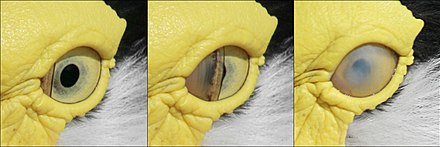Our website is made possible by displaying online advertisements to our visitors.
Please consider supporting us by disabling your ad blocker.
Nictitating membrane

The nictitating membrane (from Latin nictare, to blink) is a transparent or translucent third eyelid present in some animals that can be drawn across the eye from the medial canthus to protect and moisten it while maintaining vision. Most Anura[1][a] (tailless amphibians), some reptiles, birds, and sharks, and some mammals (such as cats, beavers, polar bears, seals and aardvarks) have full nictitating membranes; in many other mammals, a small, vestigial portion of the nictitating membrane remains in the corner of the eye. It is often informally called a third eyelid or haw; the scientific terms for it are the plica semilunaris, membrana nictitans, or palpebra tertia.
- ^ Rolleston, George; Jackson, William Hatchett (1898). Forms of Animal Life : A Manual of Comparative Anatomy, with Descriptions of Selected Types. Clarendon Press. p. 401.
- ^ Vitt, Laurie J.; Caldwell, Janalee P. (2009). "Chapter 17 – Frogs". Herpetology: An Introductory Biology of Amphibians and Reptiles (Third ed.). Academic Press. pp. 435–482. doi:10.1016/B978-0-12-374346-6.00017-1. ISBN 978-0-12-374346-6.
Cite error: There are <ref group=lower-alpha> tags or {{efn}} templates on this page, but the references will not show without a {{reflist|group=lower-alpha}} template or {{notelist}} template (see the help page).
Previous Page Next Page


